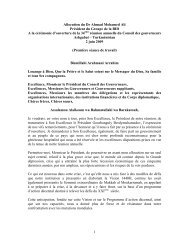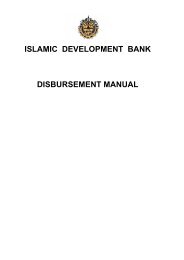Mauritania - Islamic Development Bank
Mauritania - Islamic Development Bank
Mauritania - Islamic Development Bank
You also want an ePaper? Increase the reach of your titles
YUMPU automatically turns print PDFs into web optimized ePapers that Google loves.
20<br />
75,000 t/year) of live animals to neighboring<br />
countries. The local market lacks basic<br />
infrastructure (transportation, slaughtering<br />
houses, cold chains and sanitary controls).<br />
Exports suffer from the same problems, which<br />
explain the sale of live animals, depriving<br />
the country of a substantial value-added.<br />
Similarly, there is no infrastructure for the<br />
modern treatment of animal skin. Inefficient<br />
traditional techniques produce poor quality<br />
hides sold at low prices to the export market<br />
as a raw material. There is no leather industry<br />
in <strong>Mauritania</strong>. In 2008, the volume of hides<br />
exported was 383.1 tons for the modest value<br />
of $ 177,000 representing an average price of<br />
US$ 412/ton (source: ONS).<br />
• <strong>Mauritania</strong> produces about 30% of its milk<br />
consumption, two thirds of which are selfconsumed<br />
and only one third is sold on the<br />
local market. The absence of a well-developed<br />
supply chain with sufficient capacity for milk<br />
collection, cold storage and transportation<br />
limits the access of local milk to the market<br />
and renders the local milk unable to compete<br />
with the imported –and often subsidized- milk.<br />
In 2008, <strong>Mauritania</strong> imported about US$77<br />
million of milk and dairy products (source:<br />
ONS).<br />
74. The weak management and human resource<br />
endowment in public institutions has added<br />
to these problems and led donors to support<br />
creation of independent Project Implementation<br />
Units (PIUs) that further weakened these<br />
institutions.<br />
3.3 Opportunities<br />
75. Agriculture can help to reduce poverty and<br />
enhance food security if the Government moves<br />
to address the above constraints. In fact, despite<br />
its very limited arable land area (0.5%), the<br />
agricultural potential of <strong>Mauritania</strong> is sufficient<br />
to provide the country with a reasonable level of<br />
food security and help reduce poverty, which lies<br />
mostly in rural areas.<br />
76. The potential for irrigated agriculture<br />
(137,000 ha) is largely sufficient to meet all the<br />
country needs for rice and a significant part of its<br />
vegetables and other diversification crops needs<br />
if yields are improved. It could also provide fodder<br />
for intensive dairy farming. Current average yield<br />
for paddy in <strong>Mauritania</strong> is 4.24 tons/ha with<br />
several farmers achieving 6 tons/ha and, for few<br />
of them, even 8 tons/ha. Local climate allows for<br />
a second crop but very few practice it.<br />
77. The potential in rain fed agriculture, despite<br />
the harsh climate and the irregularity of rainfall,<br />
can be better valued if the limited water and soil<br />
resources are well exploited and managed in a<br />
sustainable way. This would improve the food<br />
security of poor rural populations and uplift their<br />
economic conditions.<br />
78. Livestock also has a significant potential for<br />
improvement: it can not only satisfy a significant<br />
portion of domestic milk demand but also<br />
supply red meat for the entire domestic market<br />
and export to neighboring countries. Livestock<br />
byproducts (hides) can also be processed locally<br />
using modern techniques and bring additional<br />
value added.<br />
79. Inland fishing, currently practiced at small<br />
a scale by local communities along the Senegal<br />
river and its tributaries as well as in water<br />
reservoirs such as Foum Gleita in the Gorgol, is<br />
done in a very traditional and inefficient way<br />
and it receives little attention from the fisheries<br />
department. The effective development of<br />
inland fisheries and aquaculture can supply rural<br />
communities with a valuable local source of animal<br />
protein and generate additional employment and<br />
income.<br />
3.4 Government Strategy<br />
80. A Rural Sector <strong>Development</strong> Strategy of<br />
(RSDS) was elaborated in 1998, updated in 2001<br />
and revisited in 2006 to ensure its harmony with<br />
the orientations of PRSP I and PRSP II. The RSDS<br />
identified four strategic objectives: (i) promote the<br />
growth of the sector to ensure food security for<br />
the country; (ii) ensure equitable access to sector<br />
resources; (iii) increase the supply and availability<br />
of goods and public services required for the<br />
sustainable development of the sector and (iv)<br />
developing management capacity for promoting<br />
MCPS for <strong>Mauritania</strong>, 2011-2015






